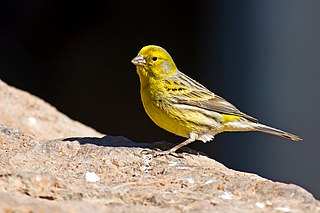
The Atlantic canary, known worldwide simply as the wild canary and also called the island canary, canary, or common canary, is a small passerine bird belonging to the genus Serinus in the finch family, Fringillidae. It is native to the Canary Islands, the Azores, and Madeira. Wild birds are mostly yellow-green, with brownish streaking on the back. The species is common in captivity and a number of colour varieties have been bred.

Ecotourism is a form of tourism involving visiting fragile, pristine, and relatively undisturbed natural areas, intended as a low-impact and often small scale alternative to standard commercial mass tourism. It means responsible travel to natural areas, conserving the environment, and improving the well-being of the local people. Its purpose may be to educate the traveler, to provide funds for ecological conservation, to directly benefit the economic development and political empowerment of local communities, or to foster respect for different cultures and for human rights. Since the 1980s, ecotourism has been considered a critical endeavor by environmentalists, so that future generations may experience destinations relatively untouched by human intervention. Several university programs use this description as the working definition of ecotourism.
In the broadest sense, cultural resources management (CRM) is the vocation and practice of managing cultural resources, such as the arts and heritage. It incorporates Cultural Heritage Management which is concerned with traditional and historic culture. It also delves into the material culture of archaeology. Cultural resources management encompasses current culture, including progressive and innovative culture, such as urban culture, rather than simply preserving and presenting traditional forms of culture.

The International Union for Conservation of Nature is an international organization working in the field of nature conservation and sustainable use of natural resources. It is involved in data gathering and analysis, research, field projects, advocacy, and education. IUCN's mission is to "influence, encourage and assist societies throughout the world to conserve nature and to ensure that any use of natural resources is equitable and ecologically sustainable".

Habitat conservation is a management practice that seeks to conserve, protect and restore habitat areas for wild plants and animals, especially conservation reliant species, and prevent their extinction, fragmentation or reduction in range. It is a priority of many groups that cannot be easily characterized in terms of any one ideology.

The western capercaillie, also known as the wood grouse, heather cock, or just capercaillie, is the largest member of the grouse family. The largest known specimen, recorded in captivity, had a weight of 7.2 kg (16 lb). The species shows extreme sexual dimorphism, with the male twice the size of the female. Found across Eurasia, this ground-living forest bird is renowned for its mating display. The worldwide population is in the category "least concern" of the IUCN, but the populations of Central Europe are declining and endangered or already extinct.
Rescue archaeology, sometimes called preventive archaeology, salvage archaeology, commercial archaeology, contract archaeology, or compliance archaeology, is state-sanctioned, for-profit archaeological survey and excavation carried out in advance of construction or other land development. These conditions could include, but are not limited to, highway projects, major construction, the flood plain of a proposed dam, or even before the onset of war. Unlike traditional survey and excavation, rescue archaeology must be undertaken at speed. Rescue archaeology is included in the broader categories that are cultural resource management (CRM) and cultural heritage management (CHM).

The cheer pheasant, also known as Wallich's pheasant, is a vulnerable species of the pheasant family, Phasianidae. It is the only member in monotypic genus Catreus. The scientific name commemorates the Danish botanist Nathaniel Wallich.
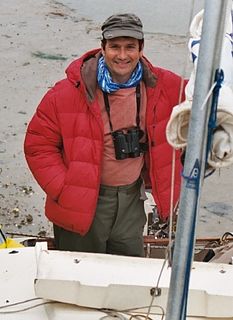
Mark Cocker is a British author and naturalist. He lives and works deep in the Norfolk countryside with his wife, Mary Muir, and two daughters in Claxton. All of his eight books have dealt with modern responses to the wild, whether found in landscape, human societies or in other species.

The regent bowerbird is a medium-sized, up to 25 cm long, sexually dimorphic bowerbird. The male bird is black with a golden orange-yellow crown, mantle and black-tipped wing feathers. It has yellow bill, black feet and yellow iris. The female is a brown bird with whitish or fawn markings, grey bill, black feet and crown. The name commemorates a prince regent of the United Kingdom.
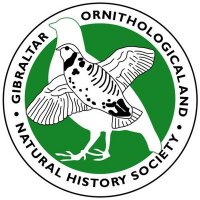
The Gibraltar Ornithological & Natural History Society (GONHS), founded in 1976, is a non-governmental, membership-based organisation committed to research into and conservation of nature in Gibraltar and the region of the Strait of Gibraltar.
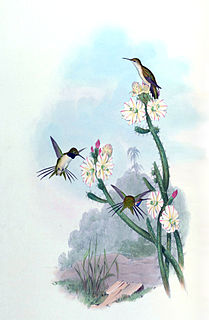
The Chilean woodstar is a small bird in the hummingbird family, Trochilidae. It is restricted to northernmost Chile with reports from southern Peru. Its natural habitats are dry shrubland and rural gardens. It is threatened by habitat loss and is classed as a critically endangered species. It is usually classified in its own genus Eulidia, but is sometimes placed with the purple-collared woodstar in the genus Myrtis. In 2013, it was classed as endangered, but recently, it was classed as critically endangered by the IUCN Red List.
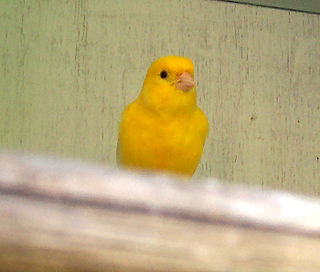
Sentinel species are organisms, often animals, used to detect risks to humans by providing advance warning of a danger. The terms primarily apply in the context of environmental hazards rather than those from other sources. Some animals can act as sentinels because they may be more susceptible or have greater exposure to a particular hazard than humans in the same environment. People have long observed animals for signs of impending hazards or evidence of environmental threats. Plants and other living organisms have also been used for these purposes.
The Global Humanitarian Forum was a non-profit foundation in Geneva, Switzerland, active from 2007 to 2010. Presided over by former United Nations Secretary General Kofi Annan, its secretariat was established by Meinrad Studer, assigned by the SDC. Subsequently the forum was led by CEO and Director General Walter Fust. The Forum intended to serve as an independent platform for debate and collaboration on global humanitarian issues. Its activities included research projects, advocacy and projects to deal with humanitarian concerns.

David Reekie is an eminent English glass sculptor who uses drawing and glass casting to express his unique vision of the human condition. His art can be found in the Victoria and Albert Museum in London and the Carnegie Museum of Art in Pittsburgh, as well as in several other public collections in the United Kingdom.
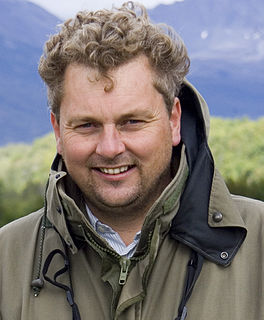
David Tipling is a professional wildlife photographer with an international reputation. His highly distinctive images have earned him many awards and accolades. Sir David Bellamy described Tipling's photographs in The National Parks and other Wild Places of Britain and Ireland as "windows of wonder". He has won the documentary award for the European Nature Photographer of the Year for his work on emperor penguins. He is the author or commissioned photographer for more than 30 books that include Collins Top Birding Spots in Britain & Ireland, The National Parks and Other Wild Places of Britain & Ireland, Attracting Wildlife to your Garden, and most recently The RSPB Guide to Digital Wildlife Photography.

Jonathan Elphick is a natural history author, editor and consultant. He is an eminent ornithologist, a qualified zoologist; Fellow of the Zoological Society of London and a Fellow of the Linnean Society of London. He is author of The Birdwatcher's Handbook: A Guide to the Birds of Britain and Ireland; Birds: The Art of Ornithology and The Natural History Museum Atlas of Bird Migration: Tracing the Great Journeys of the World's Birds, which received Bird Watching Magazine's 'Best Bird Reference Book of the Year'; as well as co-author of the Encyclopedia of Animals; the RSPB Pocket Birds; A Unique Photographic Guide to the Birds of Britain and Europe with Jonathan Woodward and The National Parks and other Wild Places of Britain and Ireland, with photography by David Tipling.
Sustainability organizations are (1) organized groups of people that aim to advance sustainability and/or (2) those actions of organizing something sustainably. Unlike many business organizations, sustainability organizations are not limited to implementing sustainability strategies which provide them with economic and cultural benefits attained through environmental responsibility. For sustainability organizations, sustainability can also be an end in itself without further justifications.

The Association for the Defense of Nature (ADN) was born in 1986 as a result of the concern of a group of people for the environment. It is an NGO that aims to protect and study nature in Andorra. The ADN pursues its aims through three basic lines of action: conservation, study and information.
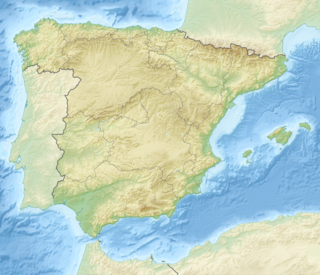
The Muniellos Nature Reserve is a protected area of woodland in Asturias, Spain. The area of the nature reserve is 5,488 ha. The main species of tree is oak: it has been described as probably the best preserved Quercus robur forest in Spain.



















